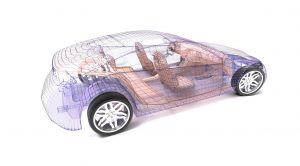
Auto manufacturers are under a mandate – increase miles per gallon to 40 MPG (40.4 MPG to be exact) in about five years. This is down from an earlier, audacious goal of 55 MPG. To get there, they need to lighten the automobiles they manufacture and the parts that go into them. This sometimes means using composites and high-performing engineered plastics.
SAFE Rule and CAFE Standards
The U.S. Department of Transportation’s National Highway Traffic Safety Administration (NHTSA) and the U.S. Environmental Protection Agency (EPA) recently released revised Safer Affordable Fuel-Efficient (SAFE) Vehicles Rule setting Corporate Average Fuel Economy (CAFE) and carbon dioxide (CO2) emissions standards for model years 2021-2026 passenger cars and light trucks.
NHTSA’s CAFE standards regulate how far vehicles must travel on a gallon of fuel. NHTSA sets CAFE standards for passenger cars and for light trucks (collectively, light-duty vehicles), and separately sets fuel consumption standards for medium- and heavy-duty trucks and engines.
The SAFE Vehicles Rule, issued in July by NHTSA and EPA, sets tough but feasible fuel economy and carbon dioxide standards that increase 1.5 percent in stringency each year from model years 2021 through 2026. These standards apply to both passenger cars and light trucks.Under the SAFE Rule, the projected overall industry average required fuel economy for 2021-2026 is 40.4 miles per gallon. The SAFE Vehicles Rule provides regulatory certainty by establishing one set of national fuel economy and CO2 emissions standards for passenger cars and light trucks.
A New Age of Composite Materials
Previously, plastics were for non-essential items like knobs, grills, light covers and things that weren’t subject to the stress and strain that steel and metallic composites are used for. This is changing.
Ray Boeman is the director of the Institute for Advanced Composites Manufacturing Innovation (IACMI) Vehicles Technology Area Scale-Up Research Facility (SURF) at Michigan State University in Detroit, Michigan. Boeman says composites have unique characteristics of flexibility that allow designers to tailor materials properties to an application.

However, he cautions that this can present challenges because composites can be complex and there’s still not a full talent base who is familiar with working with composites and all the options they offer. “Although these challenges remain, there has been increased effort through national and international collaborations, including standardization, workforce development, and improvement in digital tools,” he says.
Meanwhile, plastics and materials manufacturers are fabricating equipment that is contributing to the effort to reduce the overall weight of vehicles. Covestero is a materials manufacturer that produces a polycarbonate being used by a light truck manufacturer to mold an automotive LED fog lamp housing. The material, which is injection molded, reduced the lamp housing’s weight by 40 percent while cutting the cost of the lamp assembly by 20 percent.
Ceramic composite brakes are coming to market that enable shorter braking distances in even the toughest road and race conditions. The ceramic brakes are of extremely low weight and about 50 percent lighter than standard discs of a similar design and size. Plus, they allow a driver to have better road holding on uneven roads and improved handling.
Additive Manufacturing and 3-D Printing
Lighter parts stand to be more common and higher performing with the advent of additive manufacturing. Boeman notes that additive manufacturing software technology continues to grow. For automotive this opens up numerous possibilities. 3-D printing can now print smaller parts in high volume using composites.
In addition, 3-D printing allows for more composite materials to be used in prototyping and testing parts and components for vehicles. Thus, the laboratory gains more capability, and the automobile of the future can be built with better—and lighter—composites materials that perform. With more tools to develop composites to be used in parts, it’s now possible to develop and use materials that approach the properties and performance of metallic materials. This is a pivotal shift from non-critical components of the automobile to more critical ones.
Importantly, additive manufacturing and 3-D printing can now accommodate metallic materials as well as non-metallic ones. Says Boeman of Michigan State’s IACMI:
“Several advancements are underway that will help pave the way for broader adoption of composites. Digital tools for more efficient or effective design, material usage, and process optimization continue to evolve. Hybridization of materials that provide a compromise between weight savings, cost, and performance is an area of immediate opportunity. For example, hybrid molding (like injection over molding) of continuous and aligned fiber-reinforced thermoplastic tapes with short fiber-reinforced thermoplastics optimizes the use of more expensive materials only to most critical areas. The large, established base of plastic injection molding machines can be adapted with modest investment to address this opportunity. Better digital tools, hybridization, net-shape preforms and molding, more experienced workforce, as well as cost reduction in materials all will help proliferate composites usage in automotive.”